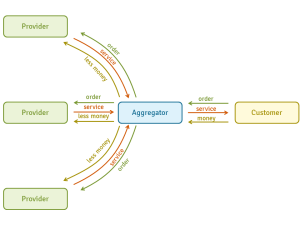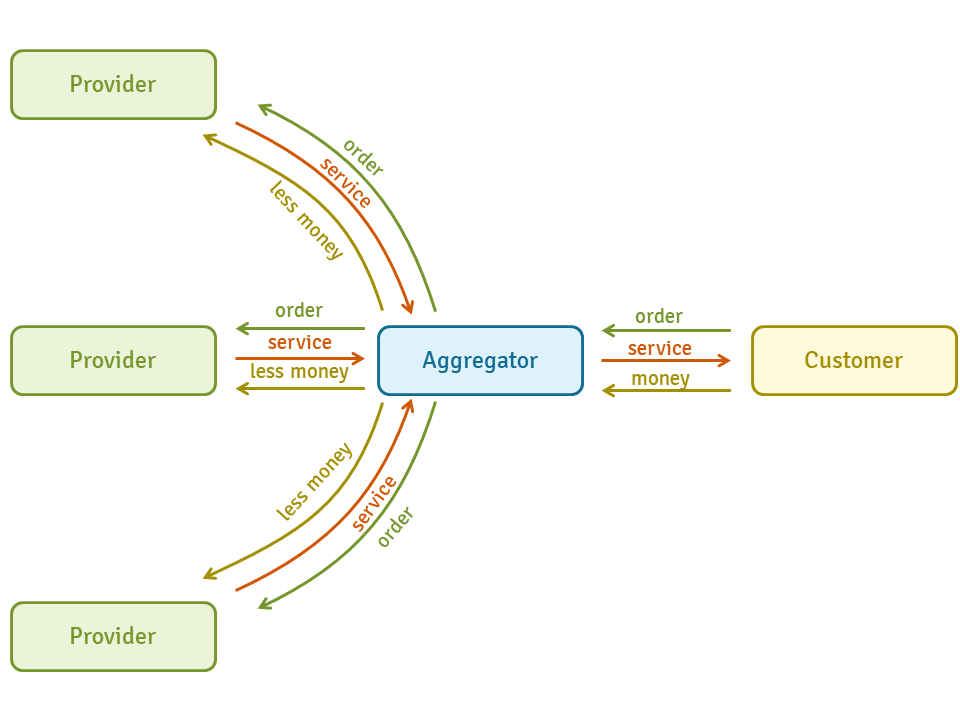Aggregator model
Aggregator model - is a new business model. The aggregator model appeal to a business attempt utilised by different companies in the e-commerce space. The company (offline or online) is not producing, storing or warehousing the goods their role is to mediate in sales. They gather information on goods or services and put them on a universal platform.
Usually, the product suppliers are the true customers of such aggregator model businesses. The aggregator contributes to increase the number of customers for supplier, in exchange for a certain fee or provision. For this purpose partners are signing up a contract. The service suppliers will never become aggregator's company employees. Supplier and Aggregergator are partners in business. Both partners always have the possibility to take or to refuse the offer from the aggregator. Aggregator company only supports them in marketing to achieve win-win situation.
This model is used by many newly created and existing companies, its often adapted by different startups from divers industries, mainly in the transportation, catering/gastronomy, accommodation. Aggregator Business Model increases on a daily basis the reason of that is ease of implementation and realisation on top high acceptance.
Examples of aggregators based businesses cabs - Uber, Ola, Taxify, Bolt, etc., Bus - Shuttl, hotels - Oyo, groceries - Grofers, food - Munchery, Uber eats, Food Panda, TinyOwl,Swiggy, etc., or travel - Make My Trip,

Fig.1. Aggregator model
Contents
- 1 Challenges
- 2 Aggregator Model Mechanics
- 3 Aggregator Revenue Model
- 4 Examples of Aggregator model
- 5 Advantages of Aggregator model
- 6 Limitations of Aggregator model
- 7 Other approaches related to Aggregator model
- 8 References
Challenges
The aggregator business model was firstly implemented in the transportation segment to satisfy the demand for services on-demand rides as well as logistics rides. Nevertheless, the maint challenge that occurs aggregator based mobility services is usually driver at the core businesses. That ensure more benefits for the driver instead for the real consumer in order to gain allegiance from taxi drivers. To eradicate such issues, aggregators introduced varied rebate and subsidies for both sides - drivers and customers.
Aggregator Model Mechanics
Partnership Model Simplified theoretical scheme
- Aggregator search for the Good/service suppliers.
- Aggregator is sharing a proposal of partnership plan with commitment to increase number of customers
- Service providers becaming now the partners with aggregator
- Aggregator creates own brand and uses many marketing strategies to attract customers attention
- Customers are now purchasing goods/services through the aggregator.
- Suppliers receive orders/customers as agreed.
- Aggregator receive the provision.
Industry All supplier are from the same industry. Aggregators gathers the good/service suppliers from the single industry and puts them under own brand. For example, Airbnb for Hotel industry, Uber for taxis, Uber eats for restaurants, Oyo for hotel rooms, etc.
Customers The aggregator business model operates with two-fold customers. Service customer and supplier are consumers for aggregator. The main role is to attract both sides to platform.
Contract An agreement between the service/goods provider where conditions are transparent. The contract ensures a win-win situation for both sides in which the partners concentrate on providing good quality service/product to the end customers. Aggregator role is to focus on marketing strategy resulting more leads for the suppliers. Basic conditions:
- Branding conditions.
- An unify quality standard.
- The provision or commission
- Take Up rate
Price There is difference between marketplace like Alibaba or Amazon for every service povided by Aggregator with no matter who is supplying there is standardized price. For example, in UberX client is paying defined price per km. Price is stated in the contract and set by aggregator.
Quality The main goal of aggregator is to ensure a standardized quality to all customers. Standardized quality is monitored on daily basis. There are often dedicating people to check quality of services/goods provided by suppliers.
Brand Most of revenue is used to build strong brand. Every supplier is using the same brand (Aggregato's) to mark service or product.
Competition In aggregtor business model partners can work for competitors which makes it hard to handle.
Aggregator Revenue Model
Service/goods suppliers play essential role in revenue. • In return for customers Aggregatos is charging suppliers with commission. For example - Uber • The partners share the minimum price from which they are able to operate on top aggregator is adding the take-up rate, then we are receiving the end price for the consumer. For example, Oyo The revenue generation is different for In a various business stage, cycle, and season revenue generation is different adjusted to the situation. Aggregators often use dynamic pricing (when demand is increasing) or season discounts what has the big impact and determines the total revenue.
Examples of Aggregator model
- Uber - Uber is an example of an aggregator model. Uber is an online transportation network company which connects riders with drivers. The company does not own any vehicles, but instead relies on independent contractors for their services. Uber has created an online platform that allows people to book rides from any location.
- Airbnb - Airbnb is another example of an aggregator model. Airbnb is an online marketplace that connects people looking for a place to stay with hosts who are offering properties for rent. Airbnb does not own any of the properties listed on its platform, but instead provides a platform that connects people who are looking for accommodations with hosts who are offering them.
- Expedia - Expedia is an online travel agency that offers a variety of services such as flight bookings, hotel bookings, car rentals, and vacation packages. Expedia acts as an aggregator, bringing together different service providers (such as airlines, hotels, and rental car companies) onto one platform. Customers can search for and compare different services, and then make bookings directly on the Expedia platform.
Advantages of Aggregator model
The Aggregator model is a new business model that has become popular in the e-commerce space. It is a platform that gathers information on goods and services, and puts them on a universal platform. There are several advantages to this model:
- Increased efficiency and convenience - Instead of having to search multiple stores or websites for a product, users can simply go to the aggregator platform and find all the products they need in one place. This increases efficiency and convenience for the user.
- More choice - The aggregator model gives users access to a much larger selection of products than any one single store or website can offer. This gives users more choice and enables them to find the exact product they are looking for.
- Greater visibility - The aggregator platform can also increase visibility for businesses, as it exposes their products to a much larger audience than they would be able to reach on their own.
- Reduced costs - The aggregator model can also help businesses reduce their costs, as the platform allows them to reach a larger audience without having to pay for advertising or promotions.
Limitations of Aggregator model
The aggregator model has some limitations that need to be taken into account before using it in business. These include:
- Lack of control over product prices - The aggregator does not have control over the prices of the products, as the supplier is the one setting the price. This means that the aggregator is unable to offer competitive pricing or discounts.
- Limited customer service - Since the aggregator does not own the products, they may not be able to provide customer service or technical support for any issues with the product.
- Difficult to track customer satisfaction - Since the aggregator does not own the products, it is difficult to track customer satisfaction or complaints.
- Risk of liability - The aggregator is at risk of liability for any issues with the products or services that are sold on the platform. This can be a major risk if the supplier is not reliable or trustworthy.
In addition to the Aggregator model, there are several other approaches related to how companies conduct business in the e-commerce space. These include:
- The Marketplace Model - This model involves providing a platform for buyers and sellers to meet and transact with each other. Amazon, eBay, and Alibaba are some of the companies that have successfully implemented this model.
- The Subscription Model - Companies that use this model offer customers access to their services in exchange for a subscription fee. Netflix and Spotify are well-known examples of companies that use this model.
- The Open Source Model - This model encourages companies to share their digital products and services with other businesses. Companies like Mozilla and WordPress use this model.
- The Freemium Model - This model offers basic services for free and charges customers extra for premium features. Dropbox and Evernote are two companies that use this model.
In summary, the Aggregator model is just one of several approaches used by companies to conduct business in the e-commerce space. Other approaches include the Marketplace Model, Subscription Model, Open Source Model, and Freemium Model.
| Aggregator model — recommended articles |
| Differential pricing — Distribution policy — Indirect sales — Direct distribution — Mass Merchandising — Limited distribution — Reintermediation — Special offering — Optional product pricing — Revocable beneficiary |
References
- Aikman J. S. (2010)., Prime Brokers Fail: The UnheededRisk to Hedge Funds, Banks, and the Financial Industry, "John Wiley & Sons", 29 Jun 2010
- Barnawal R. (2018)., Aggregator Model: How It Works?, "Plopdo"
- Great Britain: Department for Work and Pensions (2012)., Improving transfers and dealing with small pension pots: Government response to the consultation, "The Stationery Office", 17 Jul 2012
- Mora A.M., Squillero G. (2015), [1]EvoApplications 2015, "Springer", April 10, 2015
- Pahwa A. (2018)., Aggregator Business Model What Is It And How Does It Operate?,"Feedough"
- Pahwa A. (2018)., Marketplace Business Model vs. Aggregator Business Model,"Feedough"
- Remenyi D, (2010)., Proceedings of the 7th European Conference on e-Government: ECEG, "Academic Conferences Limited"
- Rupp-Serrano K. (2013)., Collection Management: Preparing Today's Bibliographies for Tomorrow's Libraries, "Routledge", 18 oct 2013
- Sorescu A., Frambach R., Singh J., Rangaswamy A., Bridges C. (2011), Innovations in Retail Business Models, "Journal of Retailing", New York University, New York, vol. 87, supp. 1, p. S3-S16
Author: Bartosz Aleksander

